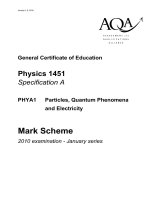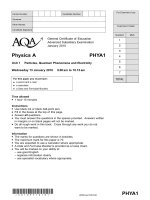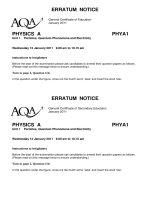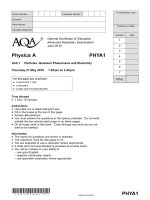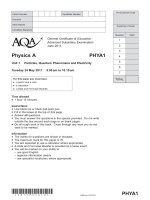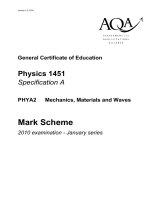- Trang chủ >>
- Khoa Học Tự Nhiên >>
- Vật lý
Vật lý A level: AQA PHYA52A w MS JUN11
Bạn đang xem bản rút gọn của tài liệu. Xem và tải ngay bản đầy đủ của tài liệu tại đây (248.48 KB, 12 trang )
Version 1.1
General Certificate of Education (A-level)
June 2011
Physics A
(Specification 2450)
PHYA5/2A
Unit 5/2A: Astrophysics
Final
Mark Scheme
Mark schemes are prepared by the Principal Examiner and considered, together with the relevant
questions, by a panel of subject teachers. This mark scheme includes any amendments made at the
standardisation events which all examiners participate in and is the scheme which was used by them
in this examination. The standardisation process ensures that the mark scheme covers the
candidates’ responses to questions and that every examiner understands and applies it in the same
correct way. As preparation for standardisation each examiner analyses a number of candidates’
scripts: alternative answers not already covered by the mark scheme are discussed and legislated for.
If, after the standardisation process, examiners encounter unusual answers which have not been
raised they are required to refer these to the Principal Examiner.
It must be stressed that a mark scheme is a working document, in many cases further developed and
expanded on the basis of candidates’ reactions to a particular paper. Assumptions about future mark
schemes on the basis of one year’s document should be avoided; whilst the guiding principles of
assessment remain constant, details will change, depending on the content of a particular examination
paper.
Further copies of this Mark Scheme are available from: aqa.org.uk
Copyright © 2012 AQA and its licensors. All rights reserved.
Copyright
AQA retains the copyright on all its publications. However, registered centres for AQA are permitted to copy material from this
booklet for their own internal use, with the following important exception: AQA cannot give permission to centres to photocopy
any material that is acknowledged to a third party even for internal use within the centre.
Set and published by the Assessment and Qualifications Alliance.
The Assessment and Qualifications Alliance (AQA) is a company limited by guarantee registered in England and Wales (company number 3644723) and a registered
charity (registered charity number 1073334).
Registered address: AQA, Devas Street, Manchester M15 6EX.
Mark Scheme – General Certificate of Education (A-level) Physics A – PHYA5/2A – June 2011
3
Instructions to Examiners
1 Give due credit for alternative treatments which are correct. Give marks for what is correct in
accordance with the mark scheme; do not deduct marks because the attempt falls short of
some ideal answer. Where marks are to be deducted for particular errors, specific instructions
are given in the marking scheme.
2 Do not deduct marks for poor written communication. Refer the scripts to the Awards meeting
if poor presentation forbids a proper assessment. In each paper, candidates are assessed on
their quality of written communication (QWC) in designated questions (or part-questions) that
require explanations or descriptions. The criteria for the award of marks on each such
question are set out in the mark scheme in three bands in the following format. The descriptor
for each band sets out the expected level of the quality of written communication of physics for
each band. Such quality covers the scope (eg relevance, correctness), sequence and
presentation of the answer. Amplification of the level of physics expected in a good answer is
set out in the last row of the table. To arrive at the mark for a candidate, their work should first
be assessed holistically (ie in terms of scope, sequence and presentation) to determine which
band is appropriate then in terms of the degree to which the candidate’s work meets the
expected level for the band.
QWC
descriptor
mark range
Good - Excellent
see specific mark scheme 5-6
Modest - Adequate
see specific mark scheme
3-4
Poor - Limited
see specific mark scheme
1-2
The description and/or explanation expected in a good answer should include a
coherent account of the following points:
see specific mark scheme
Answers given as bullet points should be considered in the above terms. Such answers
without an ‘overview’ paragraph in the answer would be unlikely to score in the top band.
3 An arithmetical error in an answer will cause the candidate to lose one mark and should be
annotated AE if possible. The candidate’s incorrect value should be carried through all
subsequent calculations for the question and, if there are no subsequent errors, the candidate
can score all remaining marks.
4 The use of significant figures is tested once on each paper in a designated question or part-
question. The numerical answer on the designated question should be given to the same
number of significant figures as there are in the data given in the question or to one more than
this number. All other numerical answers should not be considered in terms of significant
figures.
5 Numerical answers presented in non-standard form are undesirable but should not be
penalised. Arithmetical errors by candidates resulting from use of non-standard form in a
candidate’s working should be penalised as in point 3 above. Incorrect numerical prefixes and
the use of a given diameter in a geometrical formula as the radius should be treated as
arithmetical errors.
6 Knowledge of units is tested on designated questions or parts of questions in each a paper.
On each such question or part-question, unless otherwise stated in the mark scheme, the
mark scheme will show a mark to be awarded for the numerical value of the answer and a
further mark for the correct unit. No penalties are imposed for incorrect or omitted units at
intermediate stages in a calculation or at the final stage of a non-designated ‘unit’ question.
7 All other procedures including recording of marks and dealing with missing parts of answers
will be clarified in the standardising procedures.
Mark Scheme – General Certificate of Education (A-level) Physics A – PHYA5/2A – June 2011
4
GCE Physics, Specification A, PHYA5/1, Nuclear and Thermal Physics
Question 1
a
Pa
2
anti (electron) neutrino
b
2
c i
x = 4 1
c ii mass defect = [(232.98915 + 1.00867) –
(90.90368 + 138.87810 + 4 × 1.00867)] u
3
= 0.18136 u
energy released (= 0.18136 × 931) = 169 (MeV)
Total 8
Question 2
a
Al
+ P
+ n
()
()
1
b kinetic energy lost by the α particle approaching the nucleus is equal to the
potential energy gain
3
2.18 × 10
–12
=
×. ×
×
× . ×
× × . ×
r = 2.75 × 10
–15
(m)
Total 4
Q
P
Mark Scheme – General Certificate of Education (A-level) Physics A – PHYA5/2A – June 2011
5
Question 3
a
4
peak 8.7 (accept 8.0 – 9.2)
in MeV
(or peak 1.4 × 10
–12
accept 1.3 – 1.5 × 10
–12
in J )
at nucleon number 50 – 60 accept 50 – 75
sharp rise from origin and moderate fall not below 2/3 of peak height
b
energy is released/made available when binding energy per nucleon is
increased
max 3
in fission a (large) nucleus splits and in fusion (small) nuclei join
the most stable nuclei are at a peak
fusion occurs to the left of peak and fission to the right
Total 7
Question 4
a
(use of ΔQ = m
c ΔT)
2
30 × 98 = 0.100 × c × 14
c = 2100 (J kg
–1
K
–1
)
b
(use of ΔQ = m l + m
c ΔT)
3
500 × 98 = 0.100 × 3.3 × 10
5
+ 0.100 × 4200 × ΔT
(ΔT = 38°C)
T = 38°C
c the temperature would be higher
2
as the ice/water spends more time below 25°C
or heat travels in the direction from hot to cold
or ice/water first gains heat then loses heat
any one line
Total 7
Mark Scheme – General Certificate of Education (A-level) Physics A – PHYA5/2A – June 2011
6
Question 5
a graph passes through given point 2.2 × 10
–3
m
3
at 0°C straight line with
positive gradient
2
(straight) line to aim or pass through –273°C at zero volume
b
(use of n = P V/R T)
2
1.00 × 10
5
× 2.20 × 10
–3
/8.31 × 273
n = 0.0970 (moles)
c (use of mean kinetic energy = 3/2 K T)
3
= 3/2 × 1.38 × 10
–23
× 323
6.69 × 10
–21
(J) 3 sfs
d total internal energy = 6.69 × 10
–21
× 0.0970 × 6.02 × 10
23
= 390 (J)
1
e
The candidate’s writing should be legible and the spelling,
punctuation and grammar should be sufficiently accurate for the
meaning to be clear.
max 6
The candidate’s answer will be assessed holistically. The answer will be
assigned to one of three levels according to the following criteria.
High Level (Good to excellent): 5 or 6 marks
The information conveyed by the answer is clearly organised, logical and
coherent, using appropriate specialist vocabulary correctly. The form and
style of writing is appropriate to answer the question.
The candidate provides a comprehensive and coherent sequence of ideas
linking the motion of molecules to the pressure they exert on a container.
At least three of the first four points listed below must be given in a logical
order. The description should also show awareness of how a balance is
maintained between the increase in speed and shortening of the time
interval between collisions with the wall to maintain a constant pressure.
To be in this band, reference must be made to force being the rate of
change of momentum or how, in detail, the volume compensates for the
increase in temperature.
Intermediate Level (Modest to adequate): 3 or 4 marks
The information conveyed by the answer may be less well organised and
not fully coherent. There is less use of specialist vocabulary, or specialist
vocabulary may be used incorrectly. The form and style of writing is less
appropriate.
The candidate provides a comprehensive list of ideas linking the motion of
molecules to the pressure they exert on a container. At least three of the
first four points listed below are given. The candidate also knows than the
mean square speed of molecules is proportional to temperature. Using this
knowledge, an attempt is made to explain how the pressure is constant.
Mark Scheme – General Certificate of Education (A-level) Physics A – PHYA5/2A – June 2011
7
Low Level (Poor to limited): 1 or 2 marks
The information conveyed by the answer is poorly organised and may not
be relevant or coherent. There is little correct use of specialist vocabulary.
The form and style of writing may be only partly appropriate.
The candidate attempts the question and refers to at least two of the points
listed below.
Incorrect, inappropriate of no response: 0 marks
No answer or answer refers to unrelated, incorrect or inappropriate physics.
Statements expected in a competent answer should include some of
the following marking points.
molecules are in rapid random motion/many molecules are involved
molecules change their momentum or accelerate on collision with the walls
reference to Newton’s 2
nd
law either F = ma or
F = rate of change of momentum
reference to Newton’s 3
rd
law between molecule and wall
relate pressure to force P = F/A
mean square speed of molecules is proportional to temperature
as temperature increases so does change of momentum or change in
velocity
compensated for by longer time between collisions as the temperature
increases
as the volume increases the surface area increases which reduces the
pressure
Total 14
Mark Scheme – General Certificate of Education (A-level) Physics A – PHYA5/2A – June 2011
8
GCE Physics, Specification A, PHYA5/2A, Astrophysics
Question 1
a
2
mirrors correct – concave primary and convex secondary
both rays correct to eyepiece
b i
1
diagram to show two pairs of parallel rays being brought to a focus, those
further from the axis being focused closer to the mirror
b ii (use of
θ = /λ/D)
2
to give θ = 630 × 10
–9
/0.15 = 4.2 × 10
–6
rad
b iii use of s = rθ
2
to give θ = 4.8 × 10
3
/1.4 × 10
9
= 3.43 × 10
–6
(rad)
claim unlikely to be valid as this angle is smaller than the minimum angular
separation calculated in ii
Total 7
Mark Scheme – General Certificate of Education (A-level) Physics A – PHYA5/2A – June 2011
9
Question 2
a
3
main sequence curvature correct
giants and (white) dwarfs correct
absolute magnitude scale correct (from 15 to –10)
b i use of
λ
max
T = 0.0029
3
gives T = 0.0029/3.4 × 10
–7
= 8.5 × 10
3
(K)
b ii use of P
D
/P
S
= σA
D
T
D
4
/(σA
S
T
S
4
)
3
gives A
D
/A
S
= P
D
T
S
4
/(P
S
T
D
4
)
= 70000(5700/8500)
4
= 1.42 × 10
4
so r
D
/r
s
=√(1.48 × 10
4
) = 119
gives r
D
= 119 × 6.96 × 10
8
= 8.28 × 10
10
(m)
absolute magnitude
spectral class
-
10
-
5
0
5
10
15
giants
dwarfs
main
sequence
O
B
A
F
G
K
M
Mark Scheme – General Certificate of Education (A-level) Physics A – PHYA5/2A – June 2011
10
c
The candidate’s writing should be legible and the spelling,
punctuation and grammar should be sufficiently accurate for the
meaning to be clear.
max 6
The candidate’s answer will be assessed holistically. The answer will be
assigned to one of three levels according to the following criteria.
High Level (Good to excellent): 5 or 6 marks
The information conveyed by the answer is clearly organised, logical and
coherent, using appropriate specialist vocabulary correctly. The form and
style of writing is appropriate to answer the question.
The candidate states that the atmosphere of the star contains hydrogen
with electrons in the n=2 state and includes a clear description of the
absorption process in the atmosphere of the star, with reference to energy
jumps corresponding to specific frequencies of light. They describe at least
one
reason for the gap in the spectrum in terms of the de-excitation process.
Intermediate Level (Modest to adequate): 3 or 4 marks
The information conveyed by the answer may be less well organised and
not fully coherent. There is less use of specialist vocabulary, or specialist
vocabulary may be used incorrectly. The form and style of writing is less
appropriate.
The candidate may not state that electrons start in the n=2 state. Only one
of the processes, excitation or de-excitation, is satisfactorily described.
There should be some link between energy and frequency but they may not
make a clear reference to E=hf.
Low Level (Poor to limited): 1 or 2 marks
The information conveyed by the answer is poorly organised and may not
be relevant or coherent. There is little correct use of specialist vocabulary.
The form and style of writing may be only partly appropriate.
The candidate recognises that changes in electron energy levels are
involved. They may confuse absorption for emission and their explanation
of why the frequency of the light is important may be vague. They may also
be confusion between absorption due to the star’s atmosphere and the
Earth’s atmosphere.
Incorrect, inappropriate of no response: 0 marks
No answer or answer refers to unrelated, incorrect or inappropriate physics.
Mark Scheme – General Certificate of Education (A-level) Physics A – PHYA5/2A – June 2011
11
Statements expected in a competent answer should include some of
the following marking points.
• the atmosphere of the star has hydrogen atoms with electrons in
the n=2 state
• light from the star passes through the atmosphere of the star
• electrons (in the n=2) are excited into higher energy states
• they can only absorb certain amounts of energy
• these certain energies are related to specific frequencies (E=hf)
• the electrons then de-excite
• the electrons may de-excite through different energy level changes
• when the electrons de-excite the light is radiated in all directions
• this means that the intensity of the light at particular frequencies is
reduced, resulting in absorption lines
Total 15
Question 3
a i increase in wavelength (of em radiation) due to relative recessive velocity
between observer and source
1
a ii use of v = Hd
2
to give v = 65 × 25
= 1.6 × 10
3
(km s
–1
)
b i
all type 1a supernovae have same peak absolute magnitude
max 2
apparent magnitude can be measured
ref to m-M log (d/10) or inverse square law
b ii use of m-M = 5 log (d/10)
2
gives 12.9 – (–19.3) = 5 log (d/10)
log (d/10) = 6.44
d = 27.5 (Mpc)
c to make the accepted value for the distance more reliable
1
Total 8
Mark Scheme – General Certificate of Education (A-level) Physics A – PHYA5/2A – June 2011
12
Question 4
a boundary where the escape velocity = c
1
b i use of Rs = 2GM/c
2
2
to give Rs = 2 × 6.67 × 10
–11
× 60 × 10
6
× 1.99 × 10
30
/(3 × 10
8
)
2
= 1.8 × 10
11
m
b ii use of D = M/V
2
to give
D = 60 × 10
6
× 2 × 10
30
/(4/3π (1.78 × 10
11
)
3
)
= 5.1 × 10
3
kg m
–3
Total 5
UMS conversion calculator www.aqa.org.uk/umsconversion
